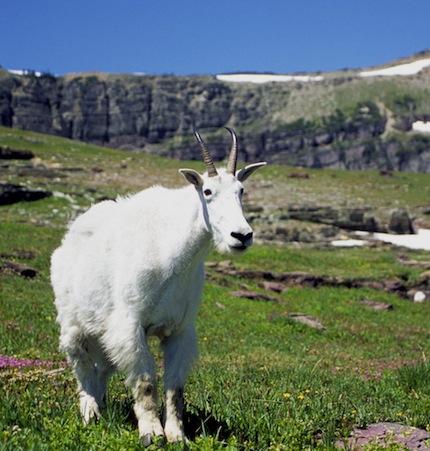So habituated to human visitors are mountain goats at Glacier National Park that they can seem as docile and innocent as sheep.
Of course, that's not the case at all. Mountain goats, just like grizzlies, bison, and wolves, are wild animals that can behave unpredicatably around humans in national parks. That point was driven home just three years ago when a hiker was fatally gored by a mountain goat in Olympic National Park.
In the wake of that incident, Olympic officials implemented a mountain goat management plan, part of which urged hikers not to urinate on trails, as the salty deposits in effect become "long linear salt licks" that lure the goats. But at the time Glacier officials said they had no plans to alter their management plans or visitor regulations when it came to wildlife.
Now, though, Glacier officials are embarking on a study with the University of Montana to better understand exactly how habituated mountain goats have become to people, trails, and roads in the Logan Pass area.
Currently, six mountain goats have been successfully collared by Park Service staff, University of Montana researchers, and Montana Fish, Wildlife & Parks personnel with GPS or VHF radio devices, the park announced Monday. Collaring efforts will continue through the fall as weather permits. It is anticipated approximately 20-25 goats will be collared of the estimated 1,500 goats in the park.
Data collected from collared goats will provide information on the animal’s use of Logan Pass and adjacent areas, as well as movement on the landscape throughout the year. Collars will remain on the goats for three years, at which point a mechanism will release allowing the collar to fall to the ground. The collar will then be retrieved by researchers. The use of the release mechanism means that goats will only be handled once.
The study also incorporates observational, temporary marking, and visitor messaging techniques. Researchers will spend time observing and recording human-goat interactions. Informational signs about human-goat interactions will be placed in the Logan Pass area. A few goats that will not be able to be collared may be temporarily marked to enable a researcher to visually distinguish between individual goats.
Glacier Wildlife Viewing: Have The Wildlife Gained The Under Hand?
Earlier this summer, the park drew criticism for its new Wildlife Viewing Policy, which states, in part, that 1) Willfully approaching, remaining, viewing, or engaging in any activity within 100 yards of bears, or wolves, or within 25 yards of any other wildlife including nesting birds; or within any distance that disturbs, displaces, or otherwise interferes with the free unimpeded movement of wildlife, or creates or contributes to a potentially hazardous condition or situation.
The problem with that wording, wrote Tony Bynum, a photographer who makes his living, in part, photographing Glacier's wildlife and scenery, is that if park visitors retreat in the face of approaching wildlife, the wildlife can become "so habituated they can actually become dangerous to spectators or observers, because they have zero fear of humans. In fact, they know they’re, 'in charge.'
"Essentially some wildlife have completely lost their fear of humans and have become more aggressive because they have learned that their aggression will actually cause humans to unnecessarily retreat. This power gives them the 'upper hand.'"
Along with the park's research on mountain goats, biologists will also conduct studies on bighorn sheep, with observational, temporary marking, and visitor messaging techniques. No collars will be placed on bighorn sheep, as individual sheep are easier to identify due to unique horn variations.
The research is a critical component of the current Going-to-the-Sun Road Corridor Management planning effort, as human-wildlife interactions within the corridor are an identified issue of concern. Interactions between humans and goats are increasing in the Logan Pass area, creating potential unhealthy and unsafe conditions.
“Mountain goats are an icon of Glacier National Park and the information gathered from this study will play a valuable role in future management decisions," said Jeff Mow, who recently took over as Glacier's superintendent. "Ensuring the safety of both mountain goats and staff conducting research is our top priority with this project.”




Comments
I understand the importance of collaring the sheep but I do think how it is not very photogenic. I look at Kurt's photo and think about several of my own, and think how it wouldn't be nearly as moving with the collar on. Sorry to those who will be taking their photos in the next three years at Logan pass.